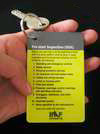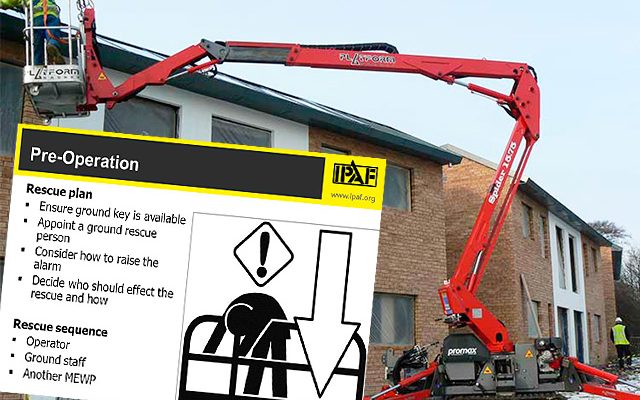
MEWP Rescue Plan
30 July 2017
Be Ready For When Things Go Wrong
Powered access platforms such as spider lifts and compact cranes are the safest way to work at height in most circumstances. However, there are occasions when things can go wrong. The key to a successful MEWP rescue plan starts with a comprehensive Risk Assessment. This includes the following essential information:
• The Manufacturer / model / ID number
• Location of use
• Date, times and duration of the MEWP rescue plan
• Ensure a ground key is available
• Appoint a ground person(s) onsite, familiarised and authorised to lower the work platform in the event of an emergency or a machine malfunction
• Best ways to raise the alarm
• Who should effect the rescue and how
• Name and contact number of authorised service engineer (if needed to call)
• And record Date the Rescue Plan was last practised
Carrying out a detailed and thorough risk assessment of the job location will identify most of the potential hazards before the job starts. But sometimes human error or acts of nature, such as extreme weather conditions, can mean that things still go wrong. It is important to have a rescue plan in place to support and assist the workforce in case of an accident or mechanical failure.
Your MEWP Rescue Plan
Most access equipment has back-up systems built into the machine. This allows the operator to return the raised platform back to ground level. Though these systems rarely fail it can still happen, so it is vital to have a MEWP rescue plan for how people can be brought down safely. Not only is it important to have a plan for rescuing someone from a MEWP, but it just as important to practise it. Someone on the ground should know what to do in an emergency and how to operate the machine’s ground controls.
Any rescue plan from an access platform should comply with the current health and safety legislation covered by the 2005 Work at Height Regulations. It is important to do a risk assessment for the rescue and keep a record of this assessment. More information regarding controlling the risk of MEWP hazards can be found on the Health and Safety Executive website.
Actioning a MEWP Rescue Plan
• Activate all normal emergency lowering procedures if possible
• Contact the manager of the site or project to report any failure of backup emergency systems
• Get the powered access platform checked by a qualified engineer to see if an onsite repair can be carried out
Basket-To-Basket Rescue
If it is not possible to repair the lowering mechanisms then a basket-to-basket rescue may be necessary. This can be complicated and poses additional health and safety risks so it is important to follow the following steps:
• The rescue machine should be placed in the safest position to minimise any additional danger to anyone involved in the rescue
• Place the two machines adjacent to each other with the smallest possible gap between them
• Attach a double lanyard to both the person being rescued and the anchor points on both machines before the rescue takes place
• Never overload the rescue machine as this could lead to over-tipping or delay the rescue operation
• In exceptional circumstances where a basket-to-basket rescue is not feasible, emergency evacuation systems such as a crane rescue could be used.
Summary
Having a MEWP rescue plan is an essential part of planning a job. Though access equipment is safe and efficient, there are rare occasions when jobs don’t go to plan. Carry out a full risk assessment, keep a record of any rescue situation as it happens. Always try the simplest solution first before attempting a more complicated rescue procedure. The best situation is to resolve the problem quickly and carefully. And remember to practice for such an event.
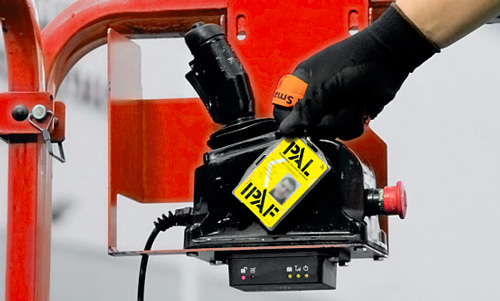
Do You Have A PAL Card?
23 July 2017
A PAL card is essential and required by law
The International Powered Access Federation (IPAF) globally-recognised PAL certification is proof of platform operator training to the highest standard.
The Powered Access Licence – PAL Card – is awarded to all operators of access equipment who have completed their training at any one of the 600 IPAF-approved training centres. It is recognised worldwide as proof of skill and ability by all the varied industries that rely on powered access platforms to carry out work at height.
Who Needs A PAL Card?
If you work at height and use access equipment, you need one. Basic training should be given to any teams or individuals who need to use powered access platforms to work at height. Not only will this ensure that the job is completed more efficiently but it will also safeguard against misuse of the equipment which could lead to serious injury or death and prosecution.
As the industries that work at height are so varied, the PAL card offers certification of a new skill on top of existing trades such as electrician, cleaner or window fitter.
Employers are obligated by law to provide proper training in the use of access platforms to comply with health and safety and work at height regulations. If employees have a PAL Card, it proves that all legal requirements have been fulfilled in that area.
The PAL Card
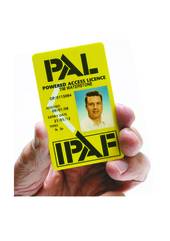
Security features including a holographic logo and the holder’s photograph and signature to prevent mis-use. Site and safety managers can verify a PAL card online or by calling the IPAF hotline: +44 (0)15395 66700.
The Smart PAL Card
All PAL Cards issued by IPAF are now smart cards and therefore all applications registered through the online system at www.ipaf-training.com will be smart cards. Smart cards are machine-readable and can be used to ensure that only trained operators can use mobile elevating work platforms (MEWPs) on site.
The Smart PAL Card looks the same as the standard PAL Card – the data stored on the card, such as the operator name, number and categories trained in, is also printed on it. The only difference is that the Smart PAL Card is marked by a wireless icon and has a chip embedded in it. The data in the chip can be read by a card reader fitted to the machine. The reader can be set up to accept certain data which in turn will allow the machine to be operated.
Other Smart PAL Card Benefits
• Using Smart PAL Cards provides options to control machine access and thereby improve safety.
• Site managers can use the system to ensure that only correctly trained operators have access to specific MEWPs.
• They can also track who has used which machine for how long, and prevent fraudulent use. Operators and contractors can prevent unauthorised users from using machines that they are responsible for under any rental contract.
• The card reader system can be used to verify if pre-use checks have been done.
• An electronic logbook can be created for individual operators – showing which machines they have operated, for how long and where.
For employers across the globe, PAL Cards are a universal way of ensuring that they meet the requirements of health and safety legislation so that all operators are fully trained in the proper and safe use of access platforms, which will increase productivity and avoid serious accidents.
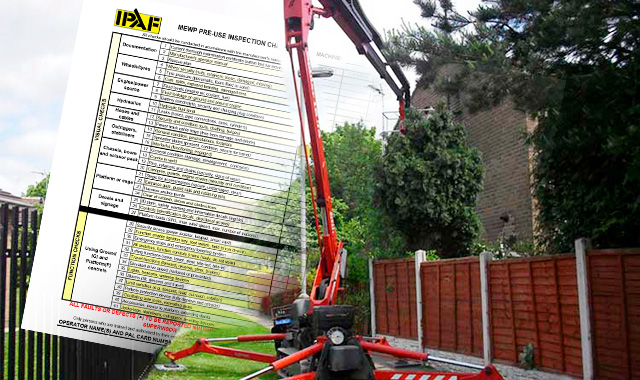
Don’t Overlook the Daily MEWP Pre-Start Inspection
16 July 2017
The Vital MEWP Pre-Start Inspection
To get the optimum performance out of your powered access platform, is vital to ensure the equipment is in the optimum condition before every use.
Maintaining and servicing access equipment will prolong its life and is required to meet health and safety regulations. A pre-start inspection should be carried out every day and all staff should be briefed on what they entail. These checks will confirm that the machinery is safe to operate and identify any potential hazards it may pose before the work at height is carried out.
The IPAF 41 Point MEWP Pre-Start Inspection
There are a number of key functions and features on access platforms which should be in full working order before the equipment is used. Even if the access equipment is rented from a reputable firm, the hirer is responsible for the health and safety of the people using it, so it is important to carry out your own checks as well as those done by the supplier.
The inspection should be a daily habit. The International Powered Access Federation (IPAF.org) has published a free checklist which can be downloaded and used to record the inspection results weekly. The checks are split between “Visual” checks and “Function” checks.
What the 41 point checklist covers
Controls – Test all lift controls before any people or equipment are raised from the ground. This should include cut out switches and emergency stop mechanisms.
Hydraulic fluid and petrol – The oil level in the tank should be full when the platform is on a level surface and there should be enough fuel in the tank to complete the job.
Maintenance – Check the vehicle for any signs of damage or age which might cause it to malfunction. This should include identifying damaged or loose hoses or fittings, rust, corrosion, holes and electrical faults.
Stability – For a mobile access platform, the brakes of the vehicle should be fully functional. The base of a powered access platform needs to be locked into position before the platform is extended or elevated. Check all stabiliser legs and extendable parts are operational before use.
After the Checklist Inspection and Before the job set up
A full risk assessment should be carried out at the site of any job to identify any potential hazards such as overhead power lines or underground services, and to check the ground conditions. Here are a few helpful things to consider before you start:
• Make sure the ground is strong enough to take the weight of the equipment before you start to lift anyone or anything.
• Clearly mark off your work area to ensure you have a safe area to complete the job.
• Only allow trained operatives to control the access equipment.
• Make sure the powered access platform is fully stabilized before operation.
• Do not exceed the maximum load capacity of the access platform.
Summary
Carrying out the relevant checks before you start will ensure that any jobs at height are completed quickly and safely. It is worth checking the equipment thoroughly yourself as part of the overall risk assessment of your job. Not only will this ensure that your equipment is well maintained and fit for purpose for longer but it will also prevent avoidable accidents.
These are a handy reminder of points to cover for pre-use and workplace inspections. Small quantities are available free from IPAF.org
IPAF Pre-Start Inspection – Boom Lift Video
May be viewed on YouTube here.
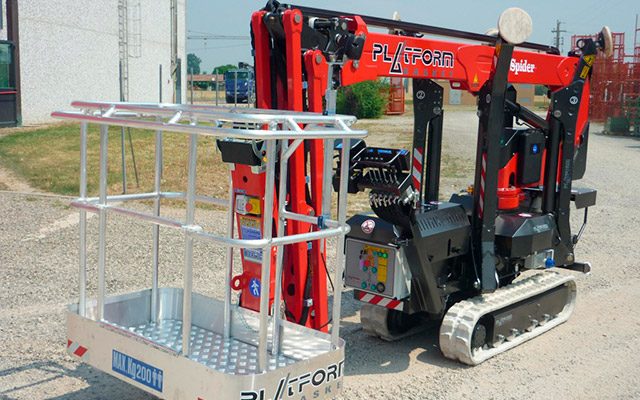
Why Use a Tracked MEWP?
9 July 2017
What are the benefits of a tracked MEWP?
In a nutshell they can tackle some of the most extreme and difficult ground conditions – both safely and effectively.
Because they run on a continuous track rather than on wheels, they have the ability to work on delicate surfaces both indoors and outdoors. The tracks spread the weight of the powered access platform over a wider area and exert a lot less pressure on the ground than when the weight is spread between four wheels. This means they are ideal for fragile surfaces including:
• Garden pathways
• Interior flooring
• Soft mud
• Wet sand
• Ice and snow
The most common type of tracked MEWP are spider lifts which are designed to access and operate in tight spaces that may be inaccessible to other types of access platforms. For some specialist jobs at height, tracked access platforms may be the only way to get the job done. If there are weight restrictions, or height and width limits to reach the job, then a compact design and ability to operate across a variety of ground conditions are a major advantage.
Promax Access offers a range of innovative narrow and low ground press tracked Spider Lift Access Platforms such as the Spider 13.65. This is an ultra compact and lightweight tracked MEWP featuring a telescopic boom with versatile fly-jib. Easy to set up with dual power options, it’s perfect for internal and external work where there is limited space and access or on fragile ground conditions
Spider lifts can be used on steep slopes and are able to fit through a standard doorway sized gap if necessary. They are used by a diverse range of industries working at height because of their flexibility and adaptability to interior and exterior working environments.
Some of the key features include:
• Able to stabilize on sloping ground
• Can be used indoors with an electric motor for noise reduction and white tracks to prevent marking floors
• Great ground clearance for difficult work sites
• Tracks and boom can be controlled proportionally
• Can fit through a standard size, single doorway or gate
However, it should be remembered that tracked access platforms may not be suitable for all jobs. An initial risk assessment prior to working outdoors may indicate that the four wheel drive capacity of a dedicated all-terrain access platform may be needed to reach jobs at height in more extreme off-road locations and weather conditions.
Summary
A tracked MEWP offers versatility for a wide range of jobs at height. They can be used on many ground surfaces and the low ground pressure provides stability and safety on internal floors, on gardens and driveways, and in soft outdoor ground conditions. Combined with a spider lift, they are one of the most adaptable and useful lightweight powered access platforms available.
